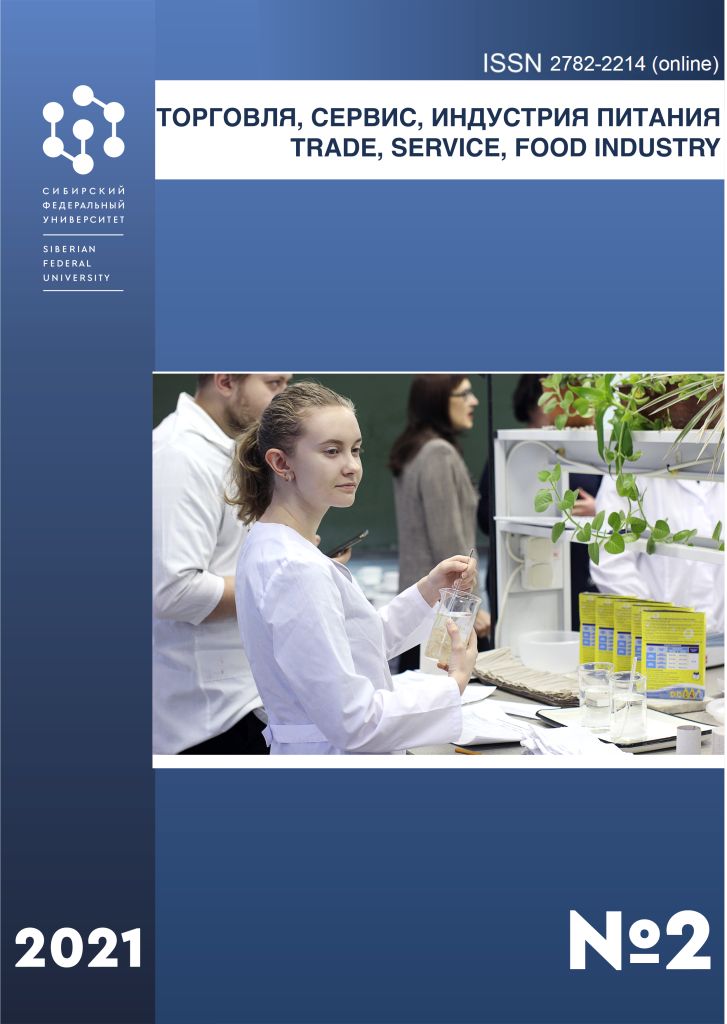Krasnoyarsk, Russian Federation
Krasnoyarsk, Krasnoyarsk, Russian Federation
UDC 641
The article describes the relevance of using soybean sprouts in the nutrition of the population, and, consequently, the feasibility of developing resource-saving technologies for sprouting soybeans. The influence of various technological parameters (temperature, humidity, convection) on the rate of germination of soybeans in a steam convection apparatus has been determined; the organoleptic indicators of the quality of sprouts were evaluated for various parameters of germination. An rational technology has been developed for germinating dry soybeans to sprouts 5 cm long. The possibility of extending the shelf life of the obtained soybeans by means of intensive cooling and vacuum packaging has been studied; the storage period is set. The nutritional value of the resulting product was assessed.
soybeans, seedlings, vegetable protein, germination technology, increased nutritional value
1. Borodin, E.A., Shtarberg, M.A., Feoktistova, N.A. & Pamirsky, I.E. (2016). Soy - from ancient beans to modern soy foods. Amur Medical Journal. 3-4 (15-16). 23-24.
2. Control methods. Biological and microbiological factors. Sanitary and epidemiological assessment of the justification for the shelf life and storage conditions of food products (MUK 4.2.1847-04): methodical directions (2004). Moscow. Federal Center for State Sanitary and Epidemiological Supervision of the Ministry of Health of Russia. 31 p.
3. Demidenko, G.A. & Khizhnyak. S.V. (2017). The influence of mineral substances on the morphological parameters of soybean seedlings. Bulletin of KrasGAU. 4. 30-37.
4. Dotsenko, S.M., Bibik I.V., Lyubimova, O.I. & Guzhel’ Y.A. (2016). Kinetics of the biochemical process of soybean seed germination. Bulletin of KrasGAU. 1. 66-74.
5. Handa, C.L., Zhang, Y., Kumari, S., Xu, J., Ida, E.I. & Chang, S.K.C. (2020). Comparative study of angiotensin i-converting enzyme (ace) inhibition of soy foods as affected by processing methods and protein isolation. PROCESSES. 8(8). 978.
6. Ivanova, M.I., Kashleva, A.I. & Razin, A.F. (2016). Sprouts - functional organic products (review). Bulletin of the Mari State University. 3/3(7). 19-29.
7. Jia, H., Zhang, B., Fan, X., Zhao, D. & Tian L. (2019) The soluble fraction of soy protein peptic hydrolysate reduces cholesterol micellar solubility and uptake. International Journal of Food Science & Technology. 54(6). 2123-2131.
8. Kosenko, T.A., Novitskaya, E.G. & Kalenik, T.K. (2016). The use of modified vegetable raw materials in the technology of specialized food products. Bulletin of KrasGAU. 2. 125-129.
9. Lyashko, M.U. (2017). The influence of various doses of the biostimulating substance albite on the formation of seedlings of soybeans and peas. Successes of modern science. 2(4). 168-172.
10. Meinlschmidt, P., Schweiggert-Weisz, U., Eisner, P., Ueberham, E. & Lehmann, J. (2016) Immunoreactivity, sensory and physicochemical properties of fermented soy protein isolate. Food Chemistry. 205. 229-238.
11. Methods of processing soybean seeds. AgroDialog. URL: http://www.agrodialog.com.ua/metody-obrabotki-semyan-soi.html.
12. Norms of physiological needs for energy and nutrients for various groups of the population of the Russian Federation (MR 2.3.1.2432-08): methodical recommendations (2009). Moscow. Federal Center for Hygiene and Epidemiology of Rospotrebnadzor. 36 p.
13. Petibskaya, V.S. (2012). Soybean: chemical composition and use. Maykop. Polygraph-Yug, 432 p.
14. Podshivalova, A.K. & Churinova, D.N. (2020). Influence of sugars on the processes of germination of seeds of soybean varieties "Zolotistaya". Bulletin of IrGSKhA. 100. 53-61.
15. Samofalova, L.A. & Safronova, O.V. (2017). Methodological approaches to germination of agricultural seeds, testing the success of germination. Grain legumes and cereals. 3 (23). 68-74.
16. Sinegovskaya, V.T., Kamanina, L.A., Vasiliev, M.M. & Petrov, O.F. (2018). The influence of plasma treatment of soybean seeds on their quality and development of seedlings. Russian agricultural science. 6. 18-21.
17. Soy // USDA Food Composition Databases. - URL: https://fdc.nal.usda.gov/fdc-app.html#/?query=soy.
18. Statsenko, E.S. (2019). Development of a food additive technology based on soybean raw materials of biotechnological modification. Technics and technology of food production. 49(3). 367-374.
19. Swieca, M., Kordowska-Wiater, M., Pytka, M., Seczyk, L. & Sikora, M. (2017). Legumes sprouts as vehicles for Lactobacillus Acidophilus - optimization of synbiotic preparation. Journal of International Scientific Publications: Agriculture & Food. 5(1000023). 26-33.
20. Technical regulations of the Customs Union "On food safety" (TR CU 021/2011). Approved. by the decision of the Commission of the Customs Union of the Eurasian Economic Community dated 09.12.2011 No. 880. Reference legal system "ConsultantPlus". URL: http://www.consultant.ru.
21. The chemical composition of Russian food products (2002). Ed. Skurikhin, I.M. & Tutelyan, V.A. Moscow. DeLi print. 236 p.
22. Zagainova, I.S. & Chizhova, M.N. Germinated seeds of legumes as a source of food and biologically active substances [Electronic resource]. Student Scientific Forum: Proceedings of the VI Intern. student scientific. conf. URL: https://scienceforum.ru/2014/article/2014002868.









